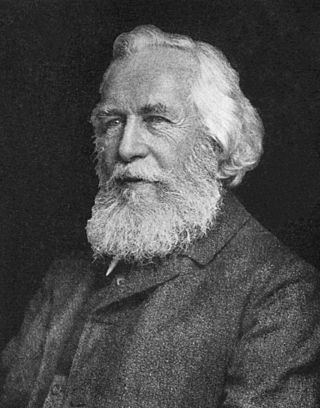
Ernst Heinrich Philipp August Haeckel was a German zoologist, naturalist, eugenicist, philosopher, physician, professor, marine biologist and artist. He discovered, described and named thousands of new species, mapped a genealogical tree relating all life forms and coined many terms in biology, including ecology, phylum, phylogeny, and Protista. Haeckel promoted and popularised Charles Darwin's work in Germany and developed the influential but no longer widely held recapitulation theory claiming that an individual organism's biological development, or ontogeny, parallels and summarises its species' evolutionary development, or phylogeny.

The Portuguese man o' war, also known as the man-of-war, is a marine hydrozoan found in the Atlantic Ocean and the Indian Ocean. It is considered to be the same species as the Pacific man o' war or bluebottle, which is found mainly in the Pacific Ocean. The Portuguese man o' war is the only species in the genus Physalia, which in turn is the only genus in the family Physaliidae.

Henry E. Rohlsen Airport is a public airport located six miles (10 km) southwest of Christiansted on the island of St. Croix in the United States Virgin Islands. The airport is named after Henry E. Rohlsen, a St. Croix native who was one of the Tuskegee Airmen during World War II.

The Sikorsky CH-53E Super Stallion is a heavy-lift helicopter operated by the United States military. As the Sikorsky S-80, it was developed from the CH-53 Sea Stallion, mainly by adding a third engine, adding a seventh blade to the main rotor, and canting the tail rotor 20°. It was built by Sikorsky Aircraft for the United States Marine Corps. The less common MH-53E Sea Dragon fills the United States Navy's need for long-range minesweeping or airborne mine countermeasures missions, and performs heavy-lift duties for the Navy. The Sikorsky CH-53K King Stallion, which has new engines, new composite rotor blades, and a wider aircraft cabin, is set to replace the CH-53E.

Siphonophorae is an order within Hydrozoa, which is a class of marine organisms within the phylum Cnidaria. According to the World Register of Marine Species, the order contains 175 species described thus far.
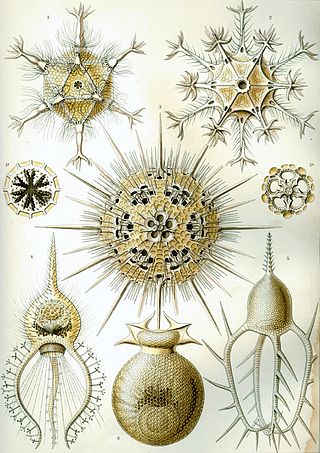
Phaeodarea or Phaeodaria is a group of amoeboid cercozoan organisms. They are traditionally considered radiolarians, but in molecular trees do not appear to be close relatives of the other groups, and are instead placed among the Cercozoa. They are distinguished by the structure of their central capsule and by the presence of a phaeodium, an aggregate of waste particles within the cell.
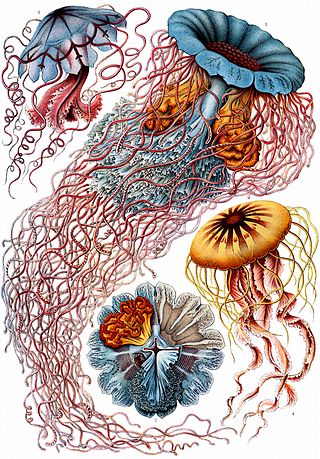
Kunstformen der Natur is a book of lithographic and halftone prints by German biologist Ernst Haeckel.

Praya dubia, the giant siphonophore, lives in the deep sea at 700 m (2,300 ft) to 1,000 m (3,300 ft) below sea level. It has been found off the coasts around the world, from Iceland in the North Atlantic to Chile in the South Pacific.

Ena is a genus of air-breathing land snails, terrestrial pulmonate gastropod mollusks in the family Enidae.
Heleobia is a genus of small freshwater and brackish water snails with a gill and an operculum, aquatic gastropod mollusks in the family Cochliopidae and the superfamily Truncatelloidea.
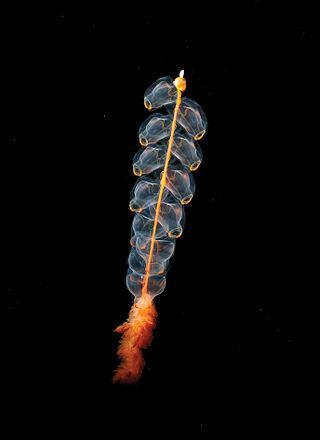
Agalmatidae, or Agalmidae, is a family of siphonophores.

Apolemia is a genus of siphonophores. It is the only genus in the monotypic family Apolemiidae.

Porpita prunella is a marine species of hydrozoan organisms within the family Porpitidae. It consists of colonies of zooids. Very little is known about this species, as there have been no confirmed sightings since its discovery in 1801 and naming by Haeckel in 1888. Being in the chondrophore group, it is likely that its behaviour is similar to the other species of the genera in the family. However there are also serious doubts as to its very existence as a separate species and may in fact be a synonym for Porpita porpita instead.

Bathyphysa conifera, sometimes called the flying spaghetti monster, is a bathypelagic species of siphonophore in the family Rhizophysidae. It is found in the northern Atlantic Ocean and off the coast of Southwestern Africa and California.
Rhizophysidae is a family of siphonophores in the suborder Cystonectae. It includes Bathyphysa conifera, sometimes called the "flying spaghetti monster".

Physonectae is a suborder of siphonophores. In Japanese it is called 胞泳.

Abylopsis is a siphonophore genus in the Abylidae. The genus contains bioluminescent species.
Mitrocomidae is an accepted family in the order Leptothecata.
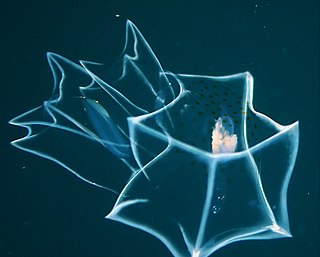
Bassia is a monotypic siphonophore genus in the family Abylidae. The genus contains the single species Bassia bassensis.

Rhodaliidae is a family of siphonophores. In Japanese they are called ヒノマルクラゲ.

















